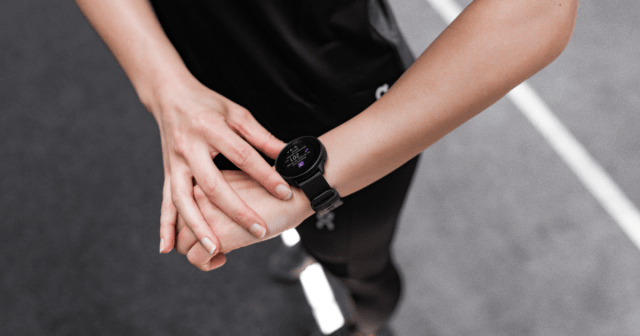Setting fitness goals can feel overwhelming – not to mention putting in the work to achieve the goals you set.
To help you get started, here’s what I’ve learned about setting and achieving goals after years of working with the whole spectrum of sports and fitness lovers from advanced athletes to average Joes.
Let’s start with the positive: You can achieve anything! But – there’s always a but – you can’t do everything at the same time.
If you have ambitious fitness goals and 38 to-dos on your list every day, no wonder if you feel overwhelmed. If this sounds familiar, you may be relieved to learn that all you have to do is pick one goal and focus. Yeah, it’s that simple!
Of course, simple doesn’t mean it’s easy – you need to be willing and able to make some hard choices.
Here are some practical tips for setting fitness goals and more importantly, how to achieve them… and a few words of warning for copycats and obsessors.
You need a map (or an app)
First, you need to specify your destination, which means separating your dreams (vague) from your goals (attainable).
For example, your dream might be to get into marathon shape but if you leave it at that and start going for a run every now and then, I’d be surprised if you ever cross the finish line. Sure, I’ve seen it happen – but it’s unlikely.
That’s like trying to go somewhere you’ve never been before just driving around hoping you’ll eventually end up in your destination. Or using a navigation app but without putting in the destination (you see where you are and which way you’re going, just no way to tell if it’s the right direction).
If you specify your dream and define “by when” and “how”, voilá, you have a goal you can start working towards.
For example: “I will run the Boston Marathon on April 15, 2019.” That’s a goal.
Now you have a destination and ETA to put into your navigation app (which could be a running program that will guide you to your destination within set timeline).
If you don’t have an app, you’ll need to create your own map.
If you don’t have an app, you’ll need to create your own map: break your goal down into smaller pieces, specific milestones that tell you whether you’re going to the right direction or straying from the path.
After years of running my own business and talking to athletes, coaches, business leaders and average Joes trying to get into shape, I’ve found the same theme keeps popping up despite different backgrounds and baselines: The way to achieve your goals is a clear plan that you commit to.
Yeah, yeah… everyone knows you need a plan but making a plan is not the real stumbling block.
Aaand… action! – with a minimalist approach
As said, planning and setting fitness goals are what most of us know we need to do – and the part we’re able to do. Following through with the plan is when it gets tricky, trying to juggle full-time demanding jobs, friends, family, chores, exercise… Phew, even thinking about squeezing ambitious fitness goals in there may feel exhausting.
If your plan is unrealistic to begin with, it won’t magically become more doable as you go along.
But if you’re determined to do it anyway, I’d suggest to ‘keep it real’ and start with making an actionable plan, emphasis on actionable.
So, instead of trying to make a more complicated and refined plan, let alone fit more stuff in there, aim for minimalism.
1. Choose
You can still do all the other stuff, too – just not all at the same time.
This first step comes back to what I mentioned in the beginning, you can’t do everything at once so you need to choose what to focus on first.
To be able to choose, you’ll need to make it crystal clear for yourself what it is that you really want to achieve – and if it’s worth the effort.
Everything worth anything comes with a cost and means compromising on something else. Are you willing to make the sacrifice it takes to achieve your goal?
If not, choose another goal – you need to be willing and ready to pay the price.
2. Focus
Take focus to the extreme if you need to – just as long as it’s temporary and not an obsessive way to lead your life all the time.
Focus doesn’t mean “yeah, training for the marathon is my focus for the next two months but I also want to learn to play the piano, read 67 books and go out with my friends every weekend”.
What it means, again, is hard choices that aren’t necessarily fun right there and then (but they’ll put a smile on your face when you cross that finish line or stand on a podium).
For example, I know a pro athlete who is so committed to his daily training and recovery routine that she won’t even try to do more than one extra thing per day when she’s getting ready for a race. She has taught herself to just say ‘no’. If she needs to go to the bank, she won’t schedule a lunch with a friend for that same day.
That may sound extreme but a way to make sure you’ve done everything in your power to achieve your important goals.
3. Limit
Weed out everything redundant and keep doing so until you’re left with only the essential things you absolutely need to do.
For example, with a business to run and fitness to maintain, I don’t consider cleaning the windows as something that supports my goals. So, I use a cleaning service. I’m willing to pay that price – in this case, it costs me actual money – to save my time and energy for things that support my core goals.
This also ties back to making hard choices: giving up the nice-to-dos and only keeping the must-dos.
Weeding out the redundant doesn’t have to mean spending actual money (I realize it’s not always possible). It means finding creative ways to make your everyday run more smoothly and save energy for the things that matter.
4. Periodize
Every project needs a timeline, so if you have a big race goal ahead that requires intensive training, you should set a start and an end for that intensive period.
Periodization allows you to give your full attention and energy to the goal at hand because you know it’s temporary. That way you won’t have to worry about the other 38 to-dos on your list because you know there will come a time to do all of those other things, too.
If you copycat pros, do it “for better or worse”
When you start making your plan, there’s nothing wrong with benchmarking and learning from the best. The problems start if you only scrape the icing and leave the rest of the cake untouched.
Not that fitness experts and pro athletes wolf down entire cakes, but you get the point: If you only take the fun and exciting stuff, ignoring the boring but important stuff, the odds are you’ll get it wrong.
For example, you take a pro athlete’s training routine (which is all about training hard, frequently and consistently) and follow suit – just go all-in as often as you can. But if you skip recovery, the most important part of every successful athlete’s routine, you’re just skimming the surface.
You may even be able to maintain that routine for a while, thinking you’re doing great because you train a lot. But, if that routine leads to you being sick or injured three months in a year, you’re doing something wrong. And it won’t get better by doing more of the wrong things.
Focusing is not the same as obsessing
Working on an ambitious fitness goal can easily get so pervasive that you forget (or just neglect) balance.
To avoid getting into an obsessive cycle, set a few simple but objective indicators that help you monitor how balanced your life is.
You may be overdoing it if…
- You’re not exactly sure when you last saw your spouse awake.
- You haven’t seen your friends in six months or you’ve lost touch with friends outside your sports circle.
- You keep running late for meetings or repeatedly miss important deadlines.
- Your resting heart rate is higher than usual first thing in the morning. (Did you recover during the night?)
These are important signals to take note of, especially if your behavior is affecting others negatively or making you more stressed.
We all have a breaking point but if you recognize when your balance starts to waver, you can still make changes and choices.
If you let obsession take over and end up in burnout, you don’t have the luxury of choosing anything anymore – you will just stop.
If you liked this post, don’t forget to share so that others can find it, too.
Or give it a thumbs up!
I like this article
Please note that the information provided in the Polar Blog articles cannot replace individual advice from health professionals. Please consult your physician before starting a new fitness program.





